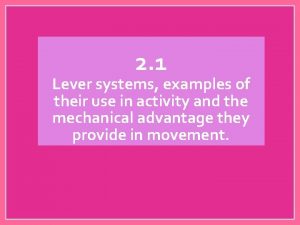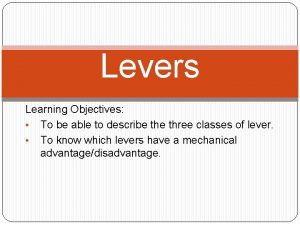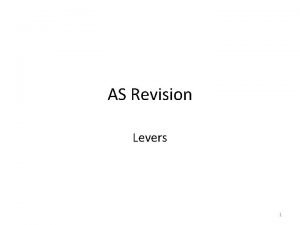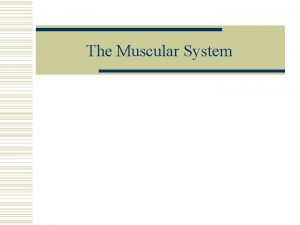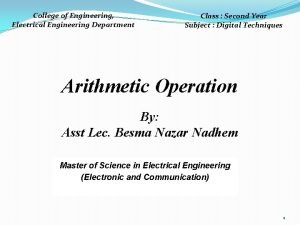College of Engineering Electrical Engineering Department Class Second










- Slides: 10

College of Engineering, Electrical Engineering Department Class : Second Year Subject : Digital Techniques Conversion between Systems By: Asst Lec. Besma Nazar Nadhem Master of Science in Electrical Engineering (Electronic and Communication) 1

Finding the Decimal Equivalent

�Octal-to-Decimal Conversion

�Hexadecimal-to-Decimal Conversion

�Decimal-to-Binary Conversion Find the binary equivalent of (13. 375)10. 13 6 3 1 0 2 2 1 0 1 1 LSP MSP The fractional part =. 375 • 0. 375 × 2 = 0. 75 with a carry of 0 • 0. 75 × 2 = 0. 5 with a carry of 1 • 0. 5 × 2 = 0 with a carry of 1 • The binary equivalent of (0. 375)10 = (. 011)2 • Therefore, the binary equivalent of (13. 375)10= (1101. 011)2

�Decimal-to-Octal Conversion Find the octal equivalent of (73. 75)10 73 9 1 8 8 8 1 1 1 LSP 0 MSP The octal equivalent of (73)10= (111)8 • The fractional part = 0. 75 • 0. 75 × 8 = 0 with a carry of 6 • The octal equivalent of (0. 75)10= (. 6)8 • Therefore, the octal equivalent of (73. 75)10 = (111. 6)8

�Decimal-to-Hexadecimal Conversion Find the hexadecimal equivalent of(82. 25)10 82 5 1 0 16 16 16 2 LSP 5 0 MSP The hexadecimal equivalent of (82)10 = (52)16 • The fractional part = 0. 25 • 0. 25 × 16 = 0 with a carry of 4 • Therefore, the hexadecimal equivalent of (82. 25)10 =(52. 4)16

�Binary–Octal and Octal–Binary Conversions • An octal number can be converted into its binary equivalent by replacing each octal digit with its three-bit binary equivalent • A binary number can be converted into an equivalent octal number by splitting the integer and fractional parts into groups of three bits, starting from the binary point on both sides. The 0 s can be added to complete the outside groups if needed. Find the binary equivalent of (374. 26)8 and the octal equivalent of (1110100111)2 The given octal number = (374. 26)8 The binary equivalent = (011 100. 010 110)2= (011111100. 010110)2 The given binary number = (1110100111)2 • (1110100111)2 = (1 110 100. 010 011 1)2= (001 110 100. 010 011 100)2= (164. 234)8

�Hex–Binary and Binary–Hex Conversions • A hexadecimal number can be converted into its binary equivalent by replacing each hex digit with its four-bit binary equivalent. • A given binary number can be converted into an equivalent hexadecimal number by splitting the integer and fractional parts into groups of four bits, starting from the binary point on both sides. The 0 s can be added to complete the outside groups if needed. Find the binary equivalent of (17 E. F 6)16 and the hex equivalent of (1011001110. 01101)2. The given hex number = (17 E. F 6)16 • The binary equivalent = (0001 0111 1110. 1111 0110)2= (000101111110110)2= (10111111011)2 The given binary number = (1011001110. 01101)2 = (10 1100 1110. 0110 1)2 • The hex equivalent = (0010 1100 1110. 0110 1000)2 = (2 CE. 6 E 8)16

�Hex–Octal and Octal–Hex Conversions • For hexadecimal–octal conversion, the given hex number is firstly converted into its binary equivalent which is further converted into its octal equivalent. • For octal–hexadecimal conversion, the octal number may first be converted into an equivalent binary number and then the binary number transformed into its hex equivalent. • Find the octal equivalent of (2 F. C 4)16 and the hex equivalent of (762. 013)8 The given hex number = (2 F. C 4)16. • The binary equivalent = (0010 1111. 1100 0100)2= (00101111. 11000100)2 = (101111. 110001)2 = (101 111. 110 001)2 = (57. 61)8. The given octal number = (762. 013)8. • The octal number = (762. 013)8 = (111 110 010. 000 001 011)2 = (111110010. 000001011)2 = (0001 1111 0010. 0000 0101 1000)2 = (1 F 2. 058)16.
 Electrical engineering department
Electrical engineering department Tum
Tum Ucla ee department
Ucla ee department 27 miles per gallon into kilometers per liter
27 miles per gallon into kilometers per liter Abb dry type transformer
Abb dry type transformer Pasadena city college police department
Pasadena city college police department Which of the following are examples of levers
Which of the following are examples of levers Advantages and disadvantages of second class levers
Advantages and disadvantages of second class levers Advantages and disadvantages of first class levers
Advantages and disadvantages of first class levers Examples of second class levers
Examples of second class levers Linked first class lever
Linked first class lever






